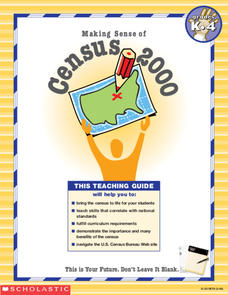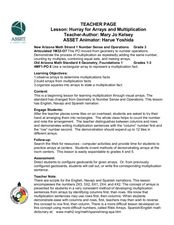Curated OER
Trigonometric Ratios
In this trigonometric ratios worksheet, students determine the value of trigonometric ratios. They find the area of triangles, determine the length of one side, and compute the degrees in an angle. This five-page worksheet...
Curated OER
Similarity and Congruence
Young scholars determine that two figures are similar or congruent by
investigating figures that are similar and figures that are congruent. They prove that two figures are similar or congruent by using definitions,
postulates, and...
Curated OER
Measuring the Area of Polygons
Fourth graders use pattern blocks to explore areas of polygons. They explain that the answers to the area of the same polygon vary according to the units of measurement used. They visualize how different units of measurement can be used...
Curated OER
Making Sense of the Census
In this unit of lessons, students make sense of the Census. They examine why a census is taken and participate in activities.
Curated OER
"it's All in the Cellar"
Seventh graders examine the process of constructing a site plan map at archaeological sites. They discuss the process of mapping techniques and calculation of percentages, create a plan site map of a cellar at Jamestown, and calculate...
Curated OER
Solving Equations Using Two Operations
Need more detail in showing your class how to solve two-step equations and proportions? This lesson plan outlines the steps young mathematicians need to solve simple equations and check their results.
Curated OER
Recognizing Patterns
Students explore the concept of patterns. In this patterns lesson, students use applets to manipulate tessellations. Students predict the next number in a sequence by recognizing patterns.
Curated OER
Statistics and Shopping
Young scholars explore the concept of using consumer data and statistics to aid in the consumer decision making process. In this consumer data and statistics lesson, students research consumer data and statistics. Young scholars...
Curated OER
Hurray for Arrays and Multiplication
Third graders begin learning about multiplication using arrays. In this multiplication with arrays lesson, 3rd graders interact with tiles on the overhead as they follow the teacher in making arrays. They write multiplication sentences...
Curated OER
Finding Area
Fourth graders explore how to find the area of a rectangular object. As a class, they discuss definition of area and strategies for finding area. The teacher models finding the area of an object by counting squares. Students observe...
Curated OER
Finding Remainders in Pascal's Triangle
Students use clock arithmetic to find remainders. In this patterns in math lesson, students explore the relationship between clock arithmetic and remainders using a computer applet. Students also identify patterns in Pascal's triangle...
Curated OER
6-8 Interior Design: Designing My Dream Room
Students analyze interior design as a profession. In this interior design lesson plan, students design their own dream bedroom and explore interior design as a profession. Students draw a scaled drawing using graph paper and appropriate...
Curated OER
Geometric Glossary
Fourth graders use drawing and paint tools to identify, draw and state several geometric terms.
Curated OER
Properties of Lines - Parallel and Perpendicular
Sixth graders identify parallel and perpendicular lines in the alphabet. For this line properties lesson, 6th graders use the letters of the alphabet to show parallel and perpendicular lines. Students open a Geogrid Mat on the computer...
Curated OER
Exploring Special Segments in Triangles
Students discover that four special segments have a common intersection point. They identify the position of the intersection point in triangles. They produce conjectures about areas of the divided triangles.
Curated OER
Angle Action
Students measure and label specified angles. In this angles lesson, students use a protractor to find angles that are acute, obtuse, and reflexive. Students then label each angle and match the angles the correct definition. This lesson...
Khan Academy
Khan Academy: Rotate 2 D Shapes in 3 D
Practice your 3D visualization skills by rotating 2D shapes. Students receive immediate feedback and have the opportunity to try questions repeatedly, watch a video or receive hints.


















